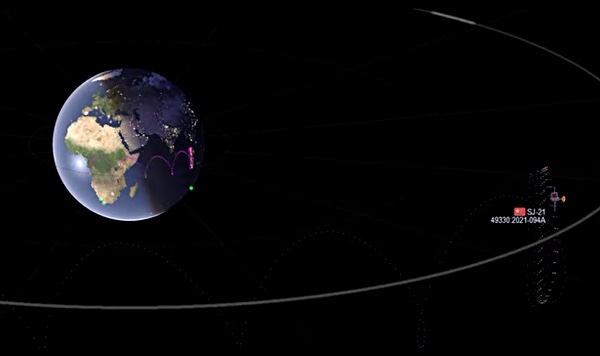A review of Chinese counterspace activitiesby Matthew Mowthorpe and Markos Trichas
|
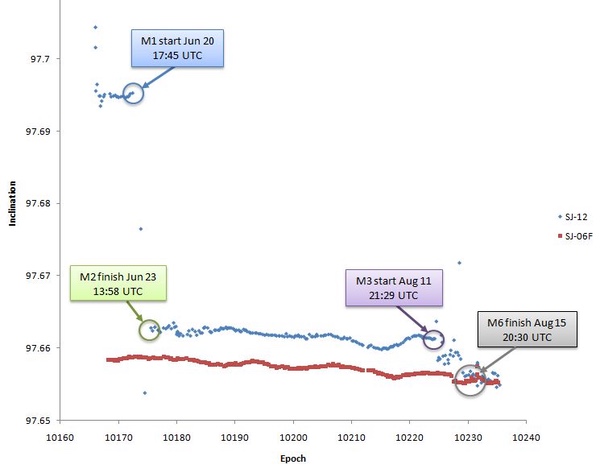 Figure 1: Inclination of SJ-12 (blue) and SJ-06F (red)[4] |
Another proximity operation occurred in LEO in 2013. Three payloads were placed in orbit at 670 kilometers from the same launch on July 19, 2013: SHIYAN-7, CHUANGXIN-3, and SHIJIAN-15. SY-7 was known to the Chinese program as TANSUO-4 and was likely fitted with a robotic arm, which interacted with a separating subsatellite, known as TANSUO-3 (CX-3), and was designed to provide optical surveillance in GEO and LEO.[5] SJ-15 was known as TANSUO-5 and was designed to maneuver and conduct proximity operations.
| Despite Chinese statements on space warfare claiming to adhere to the peaceful uses of outer space, China has designated space as a military domain. |
On August 9, 2013, TANSUO-5 maneuvered close to TS-3 and -4 passing close to TS-3 at a distance of a few kilometers. TS-5 on August 16 altered its altitude by more than 100 kilometers to conduct a close approach within a few kilometers of SHI JIAN (SJ-7), which was launched in 2005.
On October 18, TS-4 raised its orbit by several hundred meters and released a small object, which was designated as debris. TS-4 and the “debris” orbited in close proximity for several days, ranging between a few kilometers and several hundred meters and it was reported that the two objects were joined together, with TS-4 clasping the smaller “debris” object. These two objects conducted small maneuvers during 2014–15 with the distance never exceeding a few kilometers.[6]
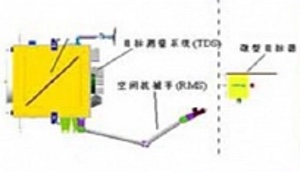 Figure 2: TANSUO-4 with robotic arm and small companion satellite[7] |
In April 2014, SJ-15 (TS-5) began to conduct maneuvers around TS-3. Between May 12 and 14, TS-5 maneuvered by lowering to match orbital planes with SJ-7, and on a trajectory that brought it above and then behind SJ-7 at a range of around 150 kilometers with a vertical separation of a few kilometers. During May, TS-5 reduced the distance to SJ-7 to within a kilometer.[8] In 2015–16, TS-5 (SJ-15) occasionally made changes to its orbit however with no apparent reason, except for perhaps demonstrating technologies to perform proximity operations.
In 2016, the AOLONG-1 (AL-1) small satellite, known as the Advanced Debris Removal Vehicle (ADRV), demonstrated using a robotic arm to capture a small piece of debris for removal from orbit. The AL-1 did not conduct any rendezvous operations with any objects and it did not appear to change its orbit during its two months on orbit.[9] The satellite used a robotic arm to grapple virtual targets.[10]
Geostationary rendezvous and proximity operations
On November 3, 2016, China launched the SHIJIAN-17 (SJ-17) into GEO. SJ-17. SJ-17 was reportedly designed test advanced technologies, however it was also fitted with an onboard optical surveillance sensor,[11] and a reported signals intelligence mission.[12] Unusually, the YZ-2 upper stage remained in obit with a perigee near GEO, and will dip down very close to and rotate around the active GEO belt for decades to come. On November 11, 2016, SJ-17 maneuvered to 162.9 degrees east in GEO, relatively close to CHINASAT-5A, a Chinese communications satellite, coming as close as few kilometers by November 30. At the end of 2016, SJ-17 drifted away and began a rapid drift east of two degrees per day, and four degrees west per day on February 9, 2017, until on March 20 it lowered its orbit and moved to rendezvous and proximity operations (RPO) with CHINASAT-20, a military communications satellite.[13]
On July 29, 2018, SJ-17 conducted a RPO with CHINASAT-1C, a communications satellite that had an unexplained anomaly and had begun drifting westward at 0.5 degrees per day. On January 23, 2018, SJ-12 raised its inclination from 0.43 to roughly four degrees, and maneuvered to a drift of four degrees per day, before reversing back to zero between July 20 and 22, 2018. The large change in inclination suggests the SJ-17 has significant delta-vee capability as plane change maneuvers are amongst the most energy intensive. SJ-17 came within 1.5 kilometers of CHINASAT-1C and highly likely conducted inspection for ten days to assess the source of the anomaly and monitor the recovery attempt of CHINSAT-1C.[14] In 2020, SJ-17 made RPO with CHINASAT-6B in January, and with SJ-20 in October.
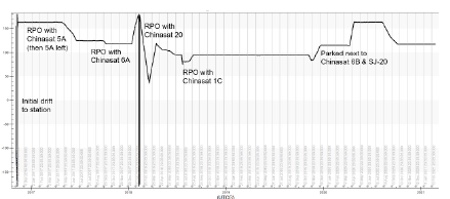 Figure 3: Longitudinal history of SJ-12 since launch in 2017 including major RPO with Chinese communications satellites[15]
|
On December 23, 2018, China launched another mission to GEO, the Tongxin Jishu Shiyan (TJS)-3. Two objects were catalogued from the launch, TJS-3 and a second object, 43917. What was unusual about 43917 is that in did a series of maneuvers to place it into GEO at 59.07 degrees east near TJS-3. It appears that 43917 is subsatellite and maintaining a close distance, about 100–200 kilometers, from TJS-3. In April 2019, TJS-3 left object 43917 and moved to another location, suggesting initial checkout took place near object 43917.[16]
| The ambiguity of RPO for in-orbit servicing and a counterspace weapons lies in the fact that the onboard tracking and guidance could be used to collide with another satellite to damage or destroy it. |
This is a significant program of testing in LEO and GEO undertaken by the Chinese government that goes beyond that could be deemed necessary for satellite inspection, space debris removal, and space situational awareness. It is likely these programs could be part of wider counterspace capabilities. The testing of a robotic arm could be used for damaging a satellite to prevent it working. As a Defense Intelligence Agency (DIA) report recently concluded “China is developing sophisticated on-orbit capabilities, such as satellite inspection and repair, at least some of which could also function as a weapon.”[17]
The ambiguity of RPO for in-orbit servicing and a counterspace weapons lies in the fact that the onboard tracking and guidance could be used to collide with another satellite to damage or destroy it. A caveat is that, to date, the Chinese RPO satellites would need higher relative velocities and longer closing distances.[18] While debris removal and in-orbit servicing could be characterized as benign activities, such assets are now directed by the PLA Strategic Support Forces.[19] This indicates that activities which were once under civilian purview could be switched when required as the program is directed and led by the PLA.
A further potential offensive use of RPO would be to install a radiofrequency jammer onboard the chaser satellite, increasing its ability to interfere with the satellite’s communications. Chinese academic papers recognized that reducing the distance with a small satellite platform would decrease the power requirements exponentially, identifying susceptible US assets such as the Advanced Extremely High Frequency satellites.[20] This, coupled with the Chinese doctrine that China can defeat the United States “network centric warfare” with “energy-centric warfare,” indicates that China has a significant interest in developing high-frequency and directed energy weapons in space.
China’s SJ-21 unusual activities
On October 24, 2021, China launched Shijian-21 (SJ-21) with China’s state-run Xinhua news agency reporting its mission as “mainly used to test and verify space debris mitigation technologies.”[21] On November 1, a new object was catalogued (2021-094C) alongside SJ-21, which is potentially its AKM (Apogee Kick Motor) as catalogued the US Space Force 18th Space Control Squadron. There has been speculation that this object alongside SJ-21 could be a sub-satellite released after arriving in GEO.[22] This speculation is based on the fact that both objects appear to remain five kilometers apart and deliberately synchronized after completing a re-rendezvous on November 15.[23] If the AKM was ejected a steadily increasing separation would be expected. The nature of the proximity operations of the AKM and SJ-21 is not known, it could be part of China’s counterspace testing.
On January 22, 2022, SJ-21 was observed to execute a large maneuver to bring itself closely next to a dead Beidou navigation satellite. SJ-21 pulled the dead satellite out of its geosynchronous orbit and placed it a few hundred miles into a graveyard orbit. SJ-21 appeared to be acting as a space tug. On January 26, SJ-21 released the Beidou and maneuvered back near GEO. The capabilities the SJ-21 demonstrated could be used in a counterspace role to move other satellites in geosynchronous orbit. The technological demonstration of the SJ-21, whileperhaps having legitimate purposes to remove defunct satellites with depleted fuel reserves to the graveyard orbit, could also serve a counterspace role.
Chinese direct-ascent ASAT
The Chinese direct ascent program’s first known tests were in 2005 and 2006, using the SC-19, also referred to as Dong Neng-1 (DN-1), and is likely a variant based on the DF-21 mobile series of ballistic missiles. On January 11, 2007, the DN-1 launched from Xichang and successfully destroyed a defunct Chinese Feng Yun-1C weather satellite at an altitude of 865 kilometers.[23] This ASAT test created a large amount of debris[25] and generated a significant amount of international condemnation.
| China is assessed to be proficient in global navigation satellite system jamming capabilities and developed both fixed and mobile systems |
On May 13, 2013, a likely test of a DA-ASAT that could reach higher orbits took place from Xichang.[26] This test was reported by the Chinese Academy of Sciences as a high-altitude scientific research mission. The Notice to Airmen (NOTAM) released by China that provided advance warning of the flight path covered a ground track which lined up with a GEO launch trajectory. Also, technical analysis conducted by the Union of Concerned Scientists, based on it re-entering above the Indian Ocean, indicated that the test had an apogee of 30,000 kilometers with a flight time of 6.7 hours.[27] This is consistent with US military official statements at the time of “nearly to GEO”. This new ASAT test variant was labelled DN-2, with an estimated operational timeframe of 2020–25.[28]
A recent National Air and Space Intelligence Center report stated that “China has military units that have begun training with anti-satellite missiles.”[29] More recently, the Director of National Intelligence reported in 2019 that: “The People’s Liberation Army (PLA) has an operational ground-based ASAT missile intended to target low-Earth-orbit satellites, and China probably intends to pursue additional ASAT weapons capable of destroying satellites up to geosynchronous Earth orbit.”[30] It is likely that DN-1 is operational as this is intended to target satellites in LEO, however, DN-2 is likely in development perhaps by 2025.
Chinese electronic warfare
Electronic warfare (EW) in the context of space is defined as the intentional interference with an adversary’s RF transmissions to or from a satellite.
China is assessed to be proficient in global navigation satellite system (GNSS) jamming capabilities and developed both fixed and mobile systems. The known systems are downlink jammers, which can affect GNSS receivers in a local area.[31] There is no open source literature that indicates that China can target the uplink jamming of GNSS satellites.
A US vessel travelling in Shanghai in 2019, the Manukai, reported that its GPS systems had been jammed at the berth, as both of the ships GPS units had lost their signals, and its AIS transponder had failed. A last-ditch emergency system, like AIS, also depended on GPS could not get a fix[32]. Indeed there was evidence that the GPS systems had been spoofed as its true position and speed had been replaced by false coordinates broadcast from the ground.
According to open source data in April 2018, China installed equipment capable of jamming communications and radar systems on two of its fortified outposts on the Spratly Islands in the South China Sea.[33]
The PLA during exercises routinely incorporates jamming and anti-jamming techniques against multiple communication, radar systems, and GPS satellite systems in exercises. A Defense Intelligence Agency report assessed that China is developing jammers to target SATCOM over a range of frequency bands including military protected extremely high frequency communications.[34]
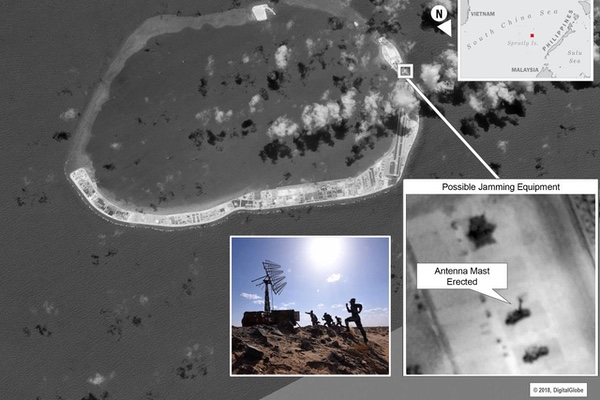 Figure 4: DigitalGlobe image commissioned by the US military showing the Jamming Equipment with its antenna extended.[35] |
Given the importance of EW in Chinese military doctrine it is likely that China is developing a ground-based synthetic aperture radar (SAR) jamming capability. The former GSD Third Department (now SSF) oversaw a division leader-grade unit, headquartered in Shanghai, responsible for the intercept of Satcom and SAR transmissions.36]
| Chinese military writings state the goal of space warfare and operations to achieve space superiority, defined as “ensuring one’s ability to fully use space while at the same time limiting, weakening, and destroying an adversary’s space forces.” |
EW provides flexibility its effects are temporary, reversible, could be applied against a specific satellite, and it does not generate any space debris. It also does not raise the bar in terms of escalation during a conflict as a kinetic attack perhaps would. Military GNSS signals are more resilient to jamming. Jamming as an interference method might degrade military GPS systems but it is unlikely to deny them completely. In a conflict between China and the US, China would probably use their jamming and anti-satellite systems to disrupt US lines of communication, command and control, situational awareness and efforts at military coordination.[37]
Chinese directed energy weapons
China is actively pursuing the development of directed energy weapon (DEW) for counterspace use. There is a significant amount of evidence of research and development, and testing but limited details on operational status of any deployed capabilities.[38] The use of lasers as a weapon is characterized in three effects:
- Dazzling a satellite’s imaging sensor
- Damage to a satellite’s imaging sensor
- Damage to the satellite bus or subsystems
The effect of dazzling is temporary, and is considered a countermeasure rather than a weapon. Relative low power levels are required to dazzle. A 10-watt laser could be sufficient to create a dazzling effect and obscure an area from being imaged.[39] The threshold between dazzling and damage is almost impossible to predict, as it would depend on knowledge of a target satellite’s internal design and protective mechanisms. For use as a weapon to cause significant damage to the sensor, a power level in the kilowatt range would be required. A very-high-power laser would be required to cause damage to the satellite bus. The damage would be due to the heating effects of the energy causing the essential components such as the thermal regulation system, the batteries, or attitude control system.[20]
It was reported in 2006 that China used a ground-based laser to dazzle or “blind” a US optical surveillance satellite on at least one occasion.[41] China has at least five sites that support China’s DEW work:
- Two sites at the Centre for Atmospheric Optics, Anhui Institute for Optics and Fine Mechanics in Hefei
- Chinese Academy of Engineering Physics in Mianyang, Sichuan Province
- Korla Missile Test Facility in Xinjiang Province
Similarly, commercial imagery of Xijiang Province below shows a similar layout to the other facilities, indicating DEW research is being conducted. The facility has four main buildings with sliding roofs, with three of the sheds connected with two vacuum spheres. The shape and size indicate that possibly chemical lasers are being used.[42] It is postulated that the equipment under the smaller sliding shed is used for tracking, while the other three are used individually or in conjunction with each other. Both the Hefei and Mianyang facilities have similarly large rectangular buildings with retractable roofs and suggest facilities where DEW aimed at satellites could have been developed.[43]
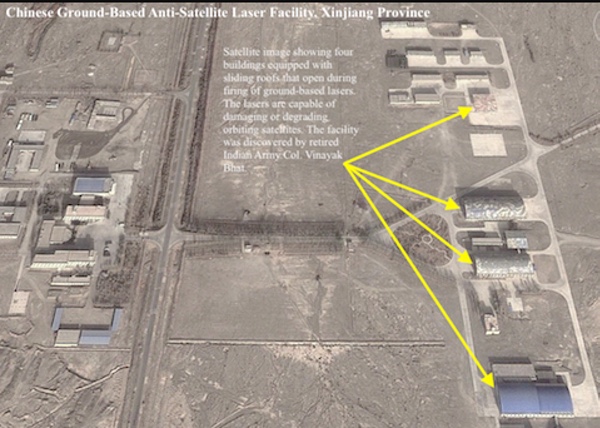 Figure 5: Chinese ground-based laser ASAT at Xinjiang Province[44] |
Chinese ground-based laser testing was possibly confirmed by a Chinese article from scientists working at the Changchun Institute of Optics, Fine Mechanics and Physics:
In 2005, we have successfully conducted a satellite blinding experiment using a 50-100 KW capacity mounted laser gun in Xinjiang province. The target was a low orbit satellite with a tilt distance of 600 km. The diameter of the telescope firing the laser beam is 0.6 m wide. The accuracy of ATP (acquisition, tracking and pointing) is less than 5 [microradians.][45]
The site of the ground-based laser was likely located at Korla, Xinjiang province. It is likely that China has developed more powerful ground-based lasers since this test.[46] A recent DIA assessment assessed that China possibly already has a “limited capability to employ laser systems against satellite sensors.”[47] It postulated that China may field a higher power system by mid-to-late 2020s capable of threatening the structure of non-optical satellites.[48]
There is limited reporting from the Changchun Institute of Optics, Fine Mechanics and Physics scientists article examining the cancelled US ABL in 2011 that China has an airborne laser program for ASAT use. In the Chinese Communist Party celebrations in 2009 a museum displayed an image of a four-engine aircraft using a laser to attack a satellite.[49] This could indicate that China is continuing to conduct research into the feasibility of using an ABL in an ASAT capability.
The same Changchun authors argue for the feasibility of a Chinese space-based laser weapon. The authors conclude “In future wars, the development of ASAT [anti-satellite] weapons is very important. Among those weapons, laser attack system enjoys significant advantages of fast response speed, robust counter-interference performance and a high target destruction rate, especially for a space-based ASAT system. So the space-based laser weapon system will be one of the major ASAT development projects.”[50] While the ability of China to develop such a system in the stated timeframe of 2023 is in question, the desire to develop such a system exists with the technical space community.
Chinese counterspace doctrine
The establishment of the Strategic Support Force (SSF) in December 2015 was tasked with integrating space closely into operations. In terms of counterspace, the SSF’s Space System Department appears to be responsible for at least the co-orbital counterspace mission. The SSF’s Network System unit indicates that it is responsible for jamming satcom and GPS, as well as computer network operations against space facilities and satellites.[51] Direct ascent capabilities may have been retained by the PLA Rocket Force.
Chinese military writings state the goal of space warfare and operations to achieve space superiority, defined as “ensuring one’s ability to fully use space while at the same time limiting, weakening, and destroying an adversary’s space forces.”[52]
Endnotes
- D. Cheng, China’s Role in Space, Strategic Studies Quarterly, Spring 2012, 68.
- D. Cheng, China’s Role in Space, Strategic Studies Quarterly, Spring 2012, 70.
- B. Weeden and V. Samson, Global Counterspace Capabilities, April 2021, 35
- Brian Weeden, “Dancing in the Dark; The Orbital Rendezvous of SJ-12 and SJ06F,” The Space Review, August 30, 2010.
- B. Weeden and V. Samson, Global Counterspace Capabilities, April 2021, 36
- B. Weeden and V. Samson, Global Counterspace Capabilities, April 2021, 38
- B. Weeden and V. Samson, Global Counterspace Capabilities, April 2021, 37
- B. Weeden and V. Samson, Global Counterspace Capabilities, April 2021, 38
- B. Weeden and V. Samson, Global Counterspace Capabilities, April 2021, 39
- “Re-Entry: Aolong-1 Space Debris Removal Demonstrator”, 28 August 2016.
- B. Weeden and V. Samson, Global Counterspace Capabilities, April 2021, 40
- D. Chen, Hearing on “China’s Advanced Weapons”, Panel on China’s Directed Energy and Electromagnetic Weapons Programmes, 23 Feb 2017.
- B. Weeden and V. Samson, Global Counterspace Capabilities, April 2021, 41
- B. Weeden and V. Samson, Global Counterspace Capabilities, April 2021, 41
- Data compiled by the COMSPOC Corporation quoted in B. Weeden and V. Samson, Global Counterspace Capabilities, April 2021, 42
- B. Weeden and V. Samson, Global Counterspace Capabilities, April 2021, 43
- DIA, Challenges to Security in Space, January 2019, 21
- B. Weeden and V. Samson, Global Counterspace Capabilities, April 2021, 44
- Namrata Goswami, Before the U.S.-China Economic and Security Review Commission Hearing on “China in Space: A Strategic Competition?” April 25, 2019.
- D. Chen, Hearing on “China’s Advanced Weapons”, Panel on China’s Directed Energy and Electromagnetic Weapons Programmes, 23 Feb 2017.
- NASA Master Catalog.
- Kristin Burke, China’s SJ-21 Framed as Demonstrating Growing On-Orbit Servicing, Assembly, and Manufacturing (OSAM) Capabilities, China Aerospace Studies Institute, December 2021, 6.
- Jonathan’s Space Report, 28 Nov 2021.
- B. Weeden and V. Samson, Global Counterspace Capabilities, April 2021, 45
- The amount of trackable debris is assessed by The Secure World Foundation as 3,280.
- B. Weeden and V. Samson, Global Counterspace Capabilities, April 2021, 47
- B. Weeden, “Through a glass, darkly: Chinese, American and Russia anti-satellite testing in space”, The Space Review, 17 March 2014.
- 2015 US Annual Report to Congress, 294.
- NASIC Report, “Competing in Space” December 2018, 12.
- D. Coats, Director of National Intelligence, Statement for the Record, Worldwide Threat Assessment of the US Intelligence Community, 29 January 2019, 17.
- B. Weeden and V. Samson, Global Counterspace Capabilities, April 2021, 53
- Mark Harris, “Ghost Ships, Crop Circles, and Soft Gold: A GPS Mystery in Shanghai,” MIT Technology Review, 15 November 2019.
- M R Gordon and J Page, “China Installed Military Jamming Equipment on Spratly Islands, US says”, Wall Street Journal, 9 April 2018.
- DIA, Challenges to Security in Space, January 2019, 20
- M R Gordon and J Page, “China Installed Military Jamming Equipment on Spratly Islands, US says”, Wall Street Journal, 9 April 2018.
- M Stokes, US Hearing on “China in Space: A Strategic Competition” , 25 April 2019, 4
- L Wortzel, The Chinese PLA and Space Warfare, 9
- B. Weeden and V. Samson, Global Counterspace Capabilities, April 2021, 54
- B. Weeden and V. Samson, Global Counterspace Capabilities, April 2021, 56
- B. Weeden and V. Samson, Global Counterspace Capabilities, April 2021, 56
- NRO Confirms Chinese Laser Test Illuminated US Spacecraft, 3 Oct 2006, Space News.
- Vinayak Bhat, “These Futuristic Chinese Space Denial Weapons Can Disable or Destroy Opposing Satellites,” The Print, March 23, 2019.
- B. Weeden and V. Samson, Global Counterspace Capabilities, April 2021, 57
- Vinayak Bhat, “These Futuristic Chinese Space Denial Weapons Can Disable or Destroy Opposing Satellites,” The Print, March 23, 2019.
- R. D. Fisher China’s Progress with Directed Energy Weapons testimony to Congress 23 Feb 2017, 6
- R. D. Fisher China’s Progress with Directed Energy Weapons testimony to Congress 23 Feb 2017, 5
- DIA, Challenges to Security in Space, January 2019, 20
- DIA, Challenges to Security in Space, January 2019, 20
- R. D. Fisher China’s Progress with Directed Energy Weapons testimony to Congress 23 Feb 2017, 6
- R. D. Fisher China’s Progress with Directed Energy Weapons testimony to Congress 23 Feb 2017, 7
- Kevin L. Pollpeter, Michael S. Chase, and Eric Heginbotham, The Creation of the Strategic Support Force and Its Implications for Chinese Military Space Operations, (Santa Monica: RAND, 2017.
- B. Weeden and V. Samson, Global Counterspace Capabilities, April 2021, 63
Note: we are using a new commenting system, which may require you to create a new account.
